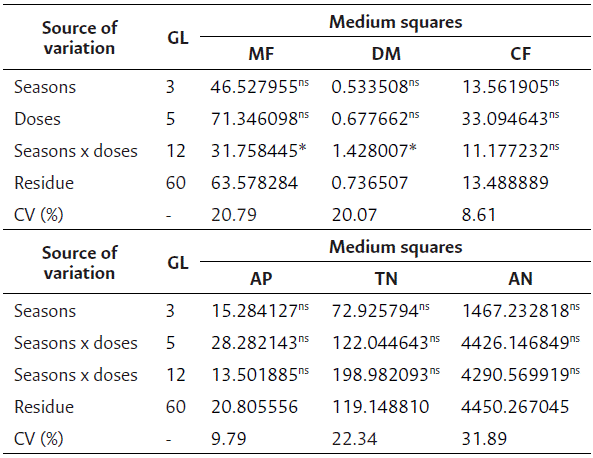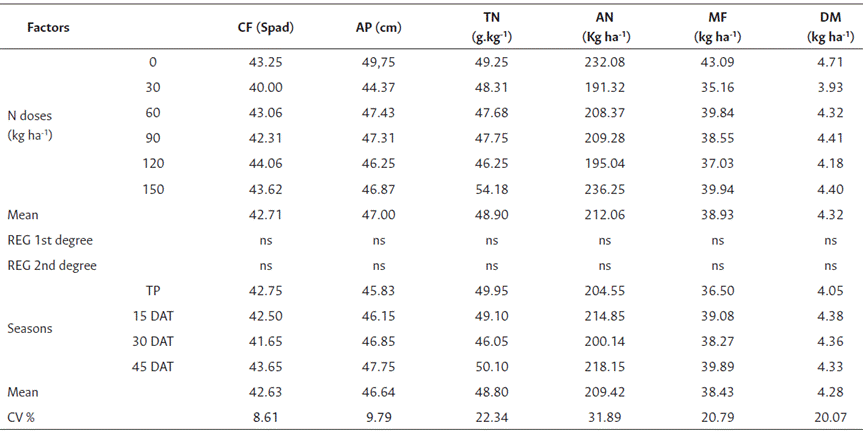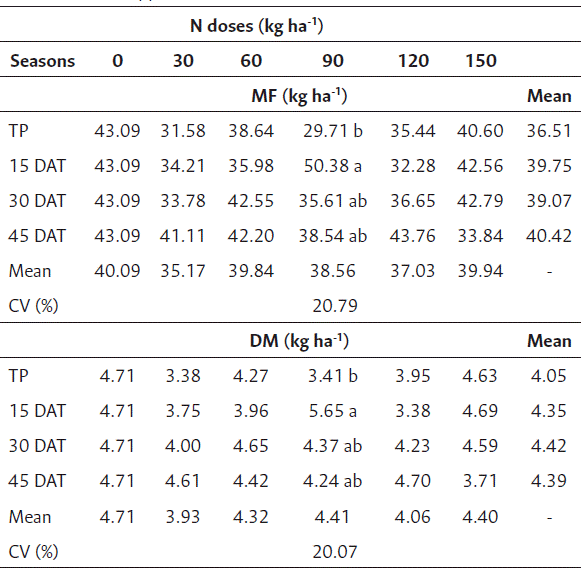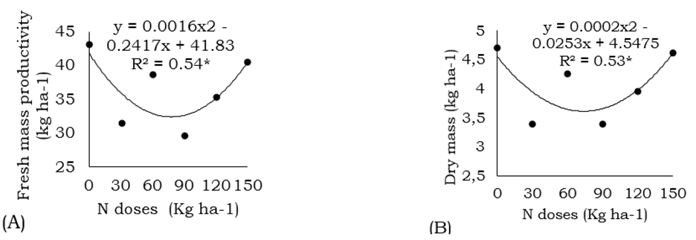Introduction
Leafy vegetables are essential for maintaining the proper functioning of the human body, as they are rich in vitamins, minerals, and dietary fibers. Therefore, studies on their mineral content are of great importance because they allow to cultivate leafy vegetables more appropriately to ensure the adequate supply of mineral nutrients for human consumption and environmental balance.
The area cultivated with vegetables in Brazil is approximately 842 000 hectares, including several species cultivated in all regions of the country (Fernandes et al., 2020). Among the leafy vegetables, spinach stands out for having an affordable price and great nutritional value, in addition to being involved in several biomedical, biofuel and nanotechnological studies.
New Zealand spinach (Tetragonia tetragonioides (Pall.)) is the most consumed spinach species in Brazil thanks to its adaptability to the tropical climate, making it suitable for warmer climates (Bekmirzaev et al., 2020). This green leafy vegetable boasts high dietary and nutritional value, low caloric content, and serves as a significant source of fiber, vitamins A, B, and C, as well as minerals such as calcium, potassium, and, notably, iron. Additionally, it contains flavonoids and polyphenols, ranking among the vegetables with the highest antioxidant capacity (Soares et al., 2016).
Soil and fertilization requirements of spinach are akin to those of Swiss chard since the stems and leaves are the consumed parts. Nitrogen, a crucial macronutrient, directly influences crop productivity, being highly demanded, and absorbed by these plants. It plays a structural role, participating in processes such as photosynthesis, respiration, multiplication, and cell differentiation, making it essential for the survival and completion of the plant’s life cycle. Therefore, nitrogen supplementation enhances productivity (Filgueira, 2008).
On the other hand, nitrogen deficiency influences enzyme function, causing the breakdown of nucleic acids and proteins, accelerating senescence, and stunting plant growth, resulting in reduced plant quality (Thapa et al., 2021). For spinach growth and yield, urea application has been more effective than other nitrogen sources (Shormin and Kibria, 2018). Hashimi et al. (2019) and Zaman et al. (2018) emphasize that the application of nitrogen, either alone or combined with manure, results in a higher number of leaves, leaf area, and plant height, positively influencing overall growth parameters and spinach production.
Productivity is directly correlated with the increase in nitrogen fertilization. However, using it in high doses for the cultivation of vegetables, in addition to burdening the production process, causes environmental imbalance. The most appropriate dose should allow the achievement of the highest productivity while minimizing the environmental damage and economic deficits (Freitas et al., 2010; Oliveira et al., 2016). The application timing is also an important management strategy aimed at improving nitrogen use efficiency. Applying the fertilizer source at the appropriate time makes the nutrient available during the crop’s demand period. This allows for a rational application of the fertilizer, enhancing productivity, and reducing costs.
Conducting fertilization in a rational manner and understanding soil nutrient dynamics as well as the nutritional requirements of the crops are essential prerequisites for achieving sustainable production. However, knowledge and studies on the mineral nutrition of New Zealand spinach are limited. Connecting nutrition to the quality of spinach plants and gaining insights into the proper dosage and optimal timing for nitrogen application can lead to valuable recommendations, becoming a crucial factor for the success of this crop. Therefore, the present study aimed to assess the impact of nitrogen doses and application timings on the productivity of New Zealand spinach.
Materials and methods
The experiment was conducted in the experimental area of the State University of Goiás, Campus Ipameri, State of Goiás, Brazil, located at 17° 43› 04›› S and 48° 08› 40›› W. The average altitude is 791 m. The climate of the region is defined as tropical (Aw), characterized by dry winters and humid summers, with average relative humidity ranging from 58 % to 81 %, annual rainfall of 1600 mm and average temperature of 23 °C (Alvares et al., 2013).
The soil of the experimental area is classified as dystrophic Red-Yellow Latosol (Santos et al., 2018). The chemical and physical analysis of the soil used showed the following values: 350, 100 and 550 g.kg-1 of clay, silt and sand, respectively; H + Al = 1.4 cmolc dm-3; Ca = 1.7 cmolc dm-3; Mg = 0.9 cmolc dm-3; P (Mehlich-1) = 4.0 mg dm-3; K = 140.0 cmolc dm-3; organic matter = 18.0 g dm-3; V % = 67.9; Cu = 3.15 mg dm-3; Fe = 69.4 mg dm-3; Mn = 18.3 mg dm-3; Zn = 1.1 mg dm-3; B = 0.17 mg dm-3.
Lime was applied based on soil analysis to increase the base saturation to 80 %. This was achieved through the application and incorporation of 92 % dolomitic limestone with a relative power of total neutralization, along with planting fertilization, carried out by applying 50 kg ha-1 of N, 180 kg ha-1 of P2O5, and 80 kg ha-1 of K2O, in the form of urea, triple superphosphate, and potassium chloride, respectively. Other soil preparation practices were conducted conventionally.
The experimental design employed a randomized block design with a 6 x 4 factorial scheme, with four replications, each comprising five plants. The treatments resulted from the combination of six doses of N applied in topdressing (0, 30, 60, 90, 120 and 150 kg ha-1) and four applications of nitrogen fertilizer (urea) at transplantation (TP), 15, 30, and 45 days after transplantation (DAT).
For the implementation of the experiment, New Zealand spinach seeds were soaked in water for 24 hours before sowing to expedite germination. Sowing was carried in polypropylene trays with 128 cells, placing three seeds in each cell, using the commercial substrate Plantmax®, composed of pine bark, superfine vermiculite, and humus. The seedlings were then transplanted 40 days after sowing, when they reached the transplant index, which is five to six definitive leaves.
The beds were 1.2 m wide, 0.30 m high, and the experimental plot comprised four lines spaced 0.30 m apart and 1 m long. Irrigations were performed twice a day to maintain soil moisture. Cultural treatments were executed as needed, and daily monitoring was conducted to detect pests and diseases.
Harvest occurred 54 days after transplanting the seedlings, collecting the useful area of each plot from the two central lines, discarding 0.30 m from each end. The variables evaluated included SPAD chlorophyll content (CF), plant height (AP), fresh mass (MF), dry mass (DM), nitrogen content (TN), and nitrogen accumulation (AN).
Chlorophyll content was assessed in the field through SPAD readings using a chlorophyll meter. Afterward, the plants were transported to the laboratory to measure shoot length in centimeters using a measuring tape. Fresh mass results were obtained from the average weight of the four central plants, weighed on an analytical balance. To evaluate dry mass, the material was washed in deionized water, dried in an oven with forced air circulation at 65 ± 2 ºC until reaching constant mass, and then weighed on an analytical balance. Subsequently, it was grounded in a Wiley mill and stored. For organic-N determination in plant dry matter, sulfuric digestion, and distillation of the extracts were performed in a Kjeldahl microstill (Kjeldahl, 1883), followed by titration of the distillate. Nitrogen accumulation was calculated as the product of dry mass and nutrient content.
The obtained results underwent analysis of variance (F-test), and means were compared using Tukey’s test at a 5 % probability for application times. Regression analysis was performed for nitrogen doses. The statistical analysis program SISVAR 5.4 was used for data processing (Ferreira, 2019).
Results
The results of the analysis of variance (Table 1) present the mean squares values for the analyzed variables at a 5 % probability level using the F-test. The data indicate that there was an interaction only for the variables fresh mass (MF) and dry mass (DM). The factors “application times” and “N doses” did not exhibit significant differences among themselves for the analyzed variables.
Table 1 Summary of the analysis of variance (mean squares) in New Zealand spinach treated with six doses of nitrogen at four times of application

Significant (*) and not significant (ns) at 5 % probability by the F-test. MF = fresh mass, DM = dry mass, CF = chlorophyll content, AP = plant height, TN = nitrogen content, AN = nitrogen accumulation.
Table 2 displays the averages for the factors concerning the analyzed variables, where no significant differences were observed in terms of doses or application times. According to the data, it was observed for the variable “plant height” that the maximum dose as well as the other doses did not result in greater plant height compared to the absence of nitrogen doses.
Table 2 Means of the regression analysis for the dose factor, and Tukey’s test mean for the time factor in New Zealand spinach, conducted with six nitrogen doses at four application times

Not significant (ns) at 5 % probability by the F-test. TP = transplant, DAT = Days after transplantation, CF = chlorophyll content, AP = plant height, TN = nitrogen content, AN = nitrogen accumulation, MF = fresh mass, DM = dry mass.
Plants fertilized with 150 kg ha-1 were found to have higher N content compared to the other doses and the control, although there was no statistical difference. Regarding accumulated N, even though it was not statistically significant, in the absence of doses, it yielded a result of 232.08 kg ha-1, accumulating 10.36 % more than the average of all tested doses, which yielded 208.05 kg ha-1. However, for the variable “SPAD chlorophyll index”, it was noted that even with increasing N doses, there was no corresponding increase in chlorophyll content.
Table 3 presents the productivity values in fresh and dry mass of spinach based on doses and times of nitrogen application. When comparing the averages among the applied doses, a significant difference was observed, with the dose of 90 kg ha-1 of N standing out and increasing the amount of fresh and dry mass when applied at 15 DAT.
Table 3 Fresh mass and dry mass of New Zealand spinach, as a function of N doses and application times

*Means followed by the same letter in the column did not differ from each other; significant (*) and not significant (ns) by Tukey’s test at a 5 % probability. TP = transplant, DAP = days after transplant.
In the variable “fresh mass”, it was observed that increasing the nutrient dose during transplantation exhibited a quadratic behavior with an inverted parabola (p<0.05). A similar trend was observed for the values of dry mass (Figure 1). In the absence of doses, the maximum values of 43.09 kg ha-1 and 4.71 kg ha-1 were found in fresh and dry mass, respectively. Conversely, in the presence of 150 kg ha-1 of N during transplantation, the values 40.60 kg ha-1 and 4.63 kg ha-1 were obtained. These results indicate that, during transplantation, the absence of doses led to greater productivity in fresh and dry mass.
Discussion
Nitrogen fertilization did not result in increased height for spinach plants. However, the obtained values were higher than those reported by Silva et al. (2016), who recorded an average plant height of 17.64 cm in a study investigating various fertilizer sources for spinach.
The nitrogen content found align with the values observed by Thomaz et al. (1975), who, in a study on macronutrient deficiencies in spinach, reported that healthy plants exhibited nitrogen levels of 56.50 g.kg-1, while nitrogen-deficient plants showed levels of 17.80 g.kg-1. Consequently, it is evident that the nitrogen levels obtained in the present study correspond to those found in healthy plants, as there were no symptoms of phytotoxicity or nutrient deficiency.
Values of accumulated nitrogen found were lower compared to the study by Grangeiro et al. (2007), where an analysis of nutrient accumulation and export in beets resulted in a maximum nitrogen accumulation of 186.10 kg ha-1. In connection with this, it is evident that spinach plants exhibited considerable efficiency in nitrogen accumulation.
This observation indicates that, in varying soil and climate conditions, the nitrogen derived from fertilizer may constitute only a minor fraction of the total nitrogen accumulated in the aerial part of the plant.
Given the history of vegetable cultivation in the study area, it is plausible that nitrogen content was supplied by residues from the preceding crop. Consequently, the potential mineralization of residues and organic nitrogen in the soil emerges as a significant nitrogen source for the plant, sustaining its fertility and creating favorable conditions for growth. Frerichs et al. (2022) emphasize that, in open- field vegetable production, substantial quantities of mineral nitrogen and nitrogen-rich residues persist in the field post-harvest.
Canali et al. (2014) observed that the SPAD reading in spinach leaves remained unaffected after varying nitrogen doses, yielding an average chlorophyll index value of 46 SPAD. Similarly, Goodarzi et al. (2020) reported a chlorophyll index ranging between 45 and 50 at nitrogen doses of 100 and 200 kg ha-1 while investigating spinach production under nitrogen fertilization. Consistent with these findings, the current study revealed SPAD chlorophyll levels ranging from 39 to 45, surpassing the values reported by Biscaro et al. (2013), who obtained SPAD index contents between 35 and 41. Barreto et al. (2013), while assessing nitrogen doses in beetroot, noted that higher N doses enhance pigment content to a certain extent, suggesting that plants do not produce chlorophyll beyond their requirements. The SPAD index correlates with chlorophyll and nitrogen content, offering an indirect estimate of plant chlorophyll levels (Padilha et al., 2020). Likewise, plants grown under suboptimal nitrogen levels exhibited a reduction in the SPAD index (Massa et al., 2018).
In a study conducted by Goodarzi et al. (2020) in Karaj, it is suggested that 71 m-2 of plants with 250 kg ha-1 of urea would meet the criteria for a healthy nitrate level in plant tissue, achieving objectives for higher spinach productivity. The growth characteristics of spinach plants significantly increased up to 150 mg N kg−1 in the investigation by Ramezanifar et al. (2022). Conversely, Jasim et al. (2022) observed a significant effect on leaf length, chlorophyll, plant fresh weight, total productivity, inflorescence length, and seed weight with the application of 40 kg N ha-1. Thapa et al. (2021) concluded that spinach production can be optimized by applying 60 kg N ha-1 + 20 t ha-1 of manure; they noted that N application has a beneficial impact up to a certain point, however, they warned about exceeding appropriate levels, as it may hinder crop growth and potentially lead to the development of various diseases.
Nutrients, particularly nitrogen, should not be applied in quantities surpassing necessary levels. Apart from the correct amount of nutrients in the soil, the proper form and timing of application are essential for the easy absorption by the plant (Singh, 2018; Selim, 2020). In the present study, spinach plants grown without nitrogen application demonstrated enhanced productivity compared to the tested doses. Therefore, under conditions like those of the conducted work, it is feasible to achieve good productivity and nutrition in New Zealand spinach plants, even with the suspension of topdressing nitrogen fertilization.
Conclusion
The application of 90 kg ha-1 of nitrogen only 15 days after transplanting stood out, obtaining a spinach productivity of 50.38 kg ha-1. However, the various nitrogen doses did not exert any influence, while the absence of nitrogen fertilization in topdressing still achieved satisfactory productivity. Therefore, it is suggested that, under conditions like those of the study, nitrogen fertilizer can be omitted in New Zealand spinach cultivation, emphasizing the advantage of reducing production costs.















